Importance of Motivation for Employee Productivity in Hilton Hotel
VerifiedAdded on 2023/01/13
|10
|2551
|92
AI Summary
This study examines the importance of motivation for enhancing employee productivity within the business organization, focusing on Hilton Hotel. It discusses the role of motivation, issues faced by employees due to lack of motivation, different motivation theories used in Hilton Hotel, and the benefits of applying these theories to improve employee productivity.
Contribute Materials
Your contribution can guide someone’s learning journey. Share your
documents today.
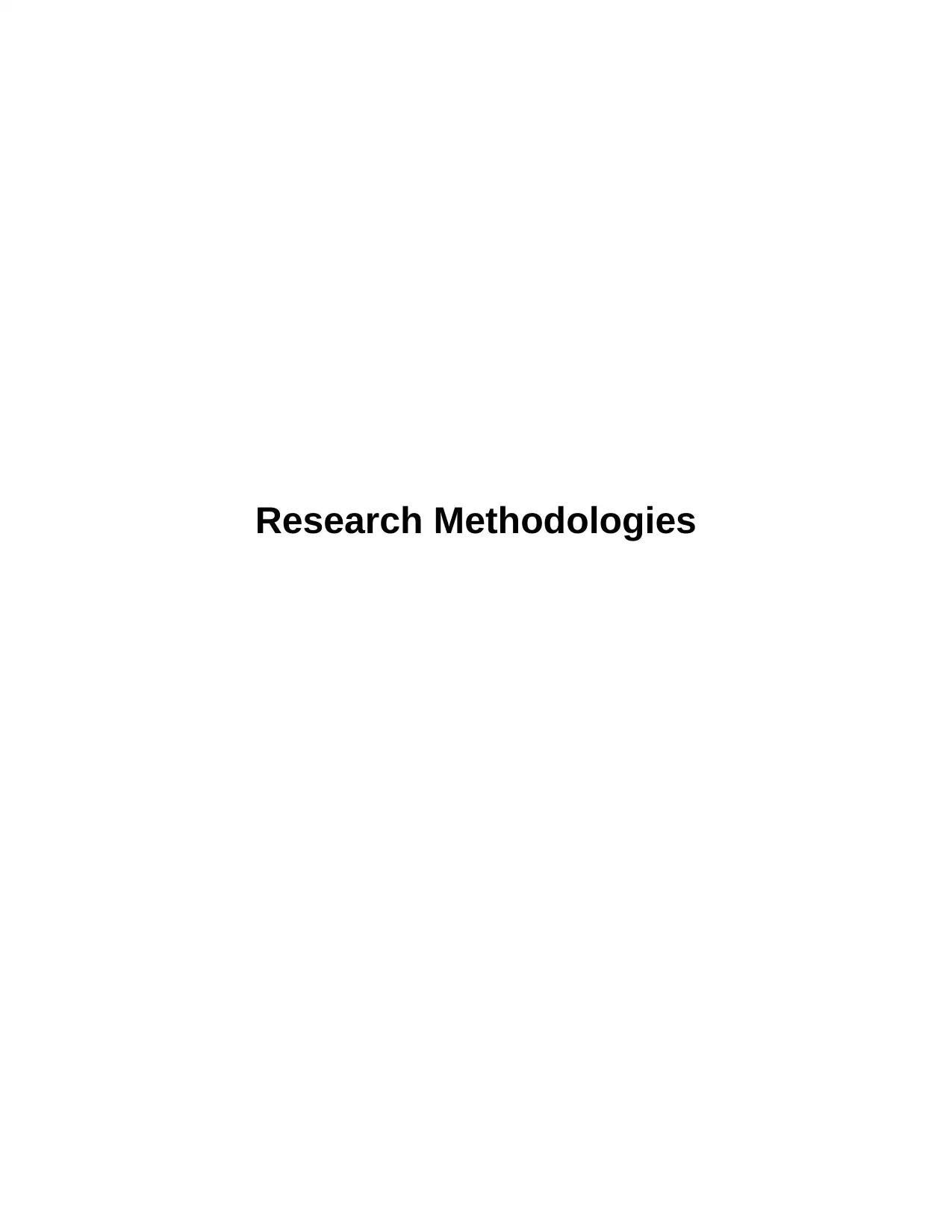
Research Methodologies
Secure Best Marks with AI Grader
Need help grading? Try our AI Grader for instant feedback on your assignments.
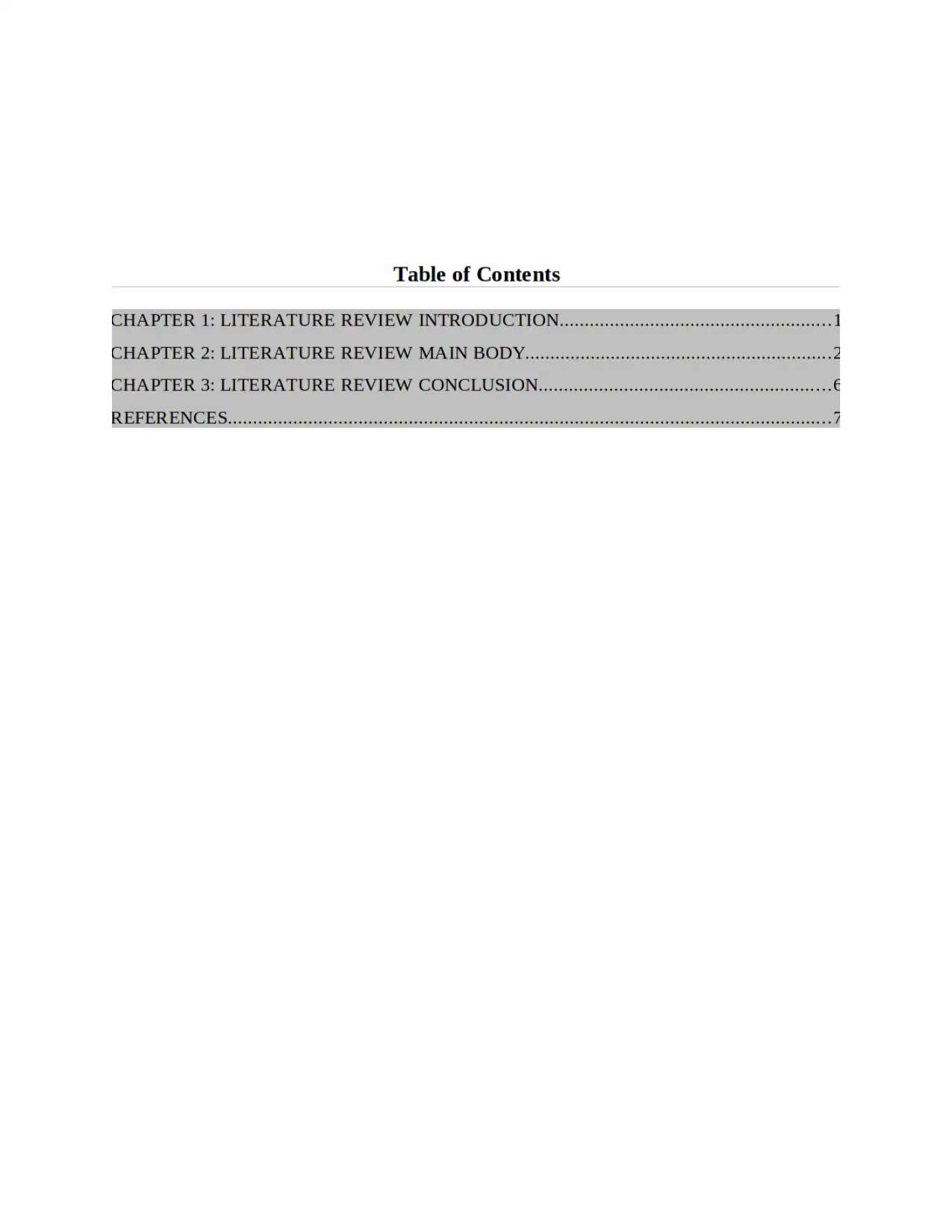
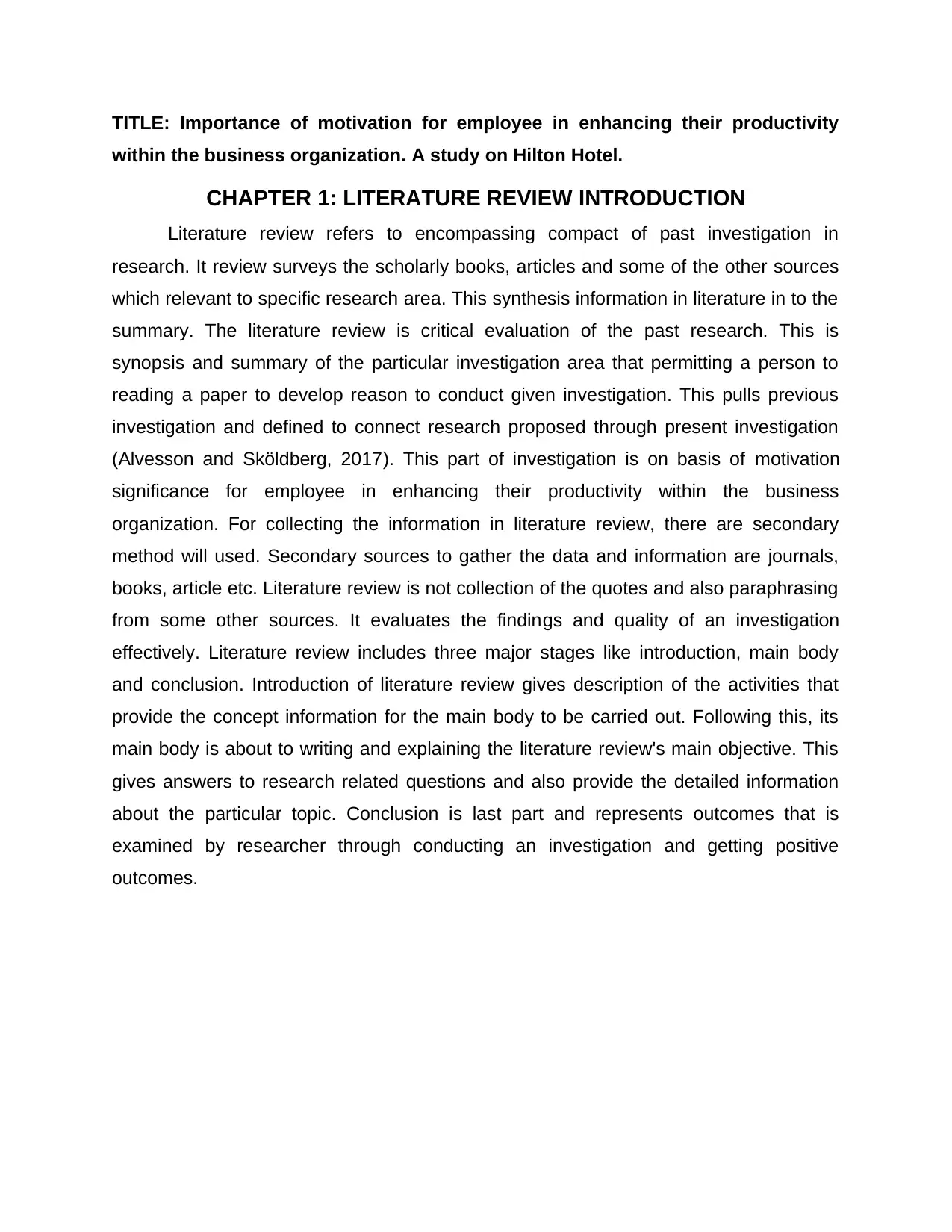
TITLE: Importance of motivation for employee in enhancing their productivity
within the business organization. A study on Hilton Hotel.
CHAPTER 1: LITERATURE REVIEW INTRODUCTION
Literature review refers to encompassing compact of past investigation in
research. It review surveys the scholarly books, articles and some of the other sources
which relevant to specific research area. This synthesis information in literature in to the
summary. The literature review is critical evaluation of the past research. This is
synopsis and summary of the particular investigation area that permitting a person to
reading a paper to develop reason to conduct given investigation. This pulls previous
investigation and defined to connect research proposed through present investigation
(Alvesson and Sköldberg, 2017). This part of investigation is on basis of motivation
significance for employee in enhancing their productivity within the business
organization. For collecting the information in literature review, there are secondary
method will used. Secondary sources to gather the data and information are journals,
books, article etc. Literature review is not collection of the quotes and also paraphrasing
from some other sources. It evaluates the findings and quality of an investigation
effectively. Literature review includes three major stages like introduction, main body
and conclusion. Introduction of literature review gives description of the activities that
provide the concept information for the main body to be carried out. Following this, its
main body is about to writing and explaining the literature review's main objective. This
gives answers to research related questions and also provide the detailed information
about the particular topic. Conclusion is last part and represents outcomes that is
examined by researcher through conducting an investigation and getting positive
outcomes.
within the business organization. A study on Hilton Hotel.
CHAPTER 1: LITERATURE REVIEW INTRODUCTION
Literature review refers to encompassing compact of past investigation in
research. It review surveys the scholarly books, articles and some of the other sources
which relevant to specific research area. This synthesis information in literature in to the
summary. The literature review is critical evaluation of the past research. This is
synopsis and summary of the particular investigation area that permitting a person to
reading a paper to develop reason to conduct given investigation. This pulls previous
investigation and defined to connect research proposed through present investigation
(Alvesson and Sköldberg, 2017). This part of investigation is on basis of motivation
significance for employee in enhancing their productivity within the business
organization. For collecting the information in literature review, there are secondary
method will used. Secondary sources to gather the data and information are journals,
books, article etc. Literature review is not collection of the quotes and also paraphrasing
from some other sources. It evaluates the findings and quality of an investigation
effectively. Literature review includes three major stages like introduction, main body
and conclusion. Introduction of literature review gives description of the activities that
provide the concept information for the main body to be carried out. Following this, its
main body is about to writing and explaining the literature review's main objective. This
gives answers to research related questions and also provide the detailed information
about the particular topic. Conclusion is last part and represents outcomes that is
examined by researcher through conducting an investigation and getting positive
outcomes.
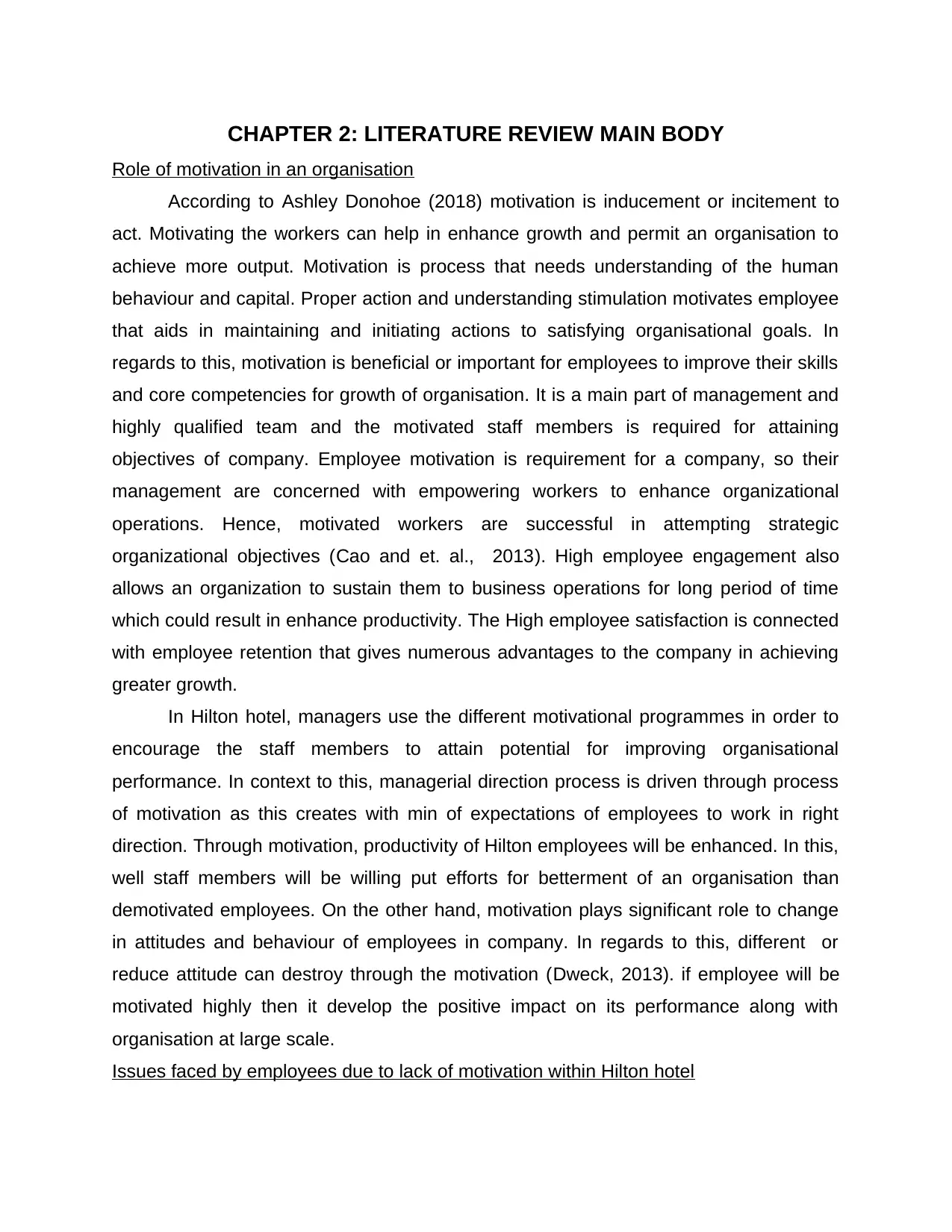
CHAPTER 2: LITERATURE REVIEW MAIN BODY
Role of motivation in an organisation
According to Ashley Donohoe (2018) motivation is inducement or incitement to
act. Motivating the workers can help in enhance growth and permit an organisation to
achieve more output. Motivation is process that needs understanding of the human
behaviour and capital. Proper action and understanding stimulation motivates employee
that aids in maintaining and initiating actions to satisfying organisational goals. In
regards to this, motivation is beneficial or important for employees to improve their skills
and core competencies for growth of organisation. It is a main part of management and
highly qualified team and the motivated staff members is required for attaining
objectives of company. Employee motivation is requirement for a company, so their
management are concerned with empowering workers to enhance organizational
operations. Hence, motivated workers are successful in attempting strategic
organizational objectives (Cao and et. al., 2013). High employee engagement also
allows an organization to sustain them to business operations for long period of time
which could result in enhance productivity. The High employee satisfaction is connected
with employee retention that gives numerous advantages to the company in achieving
greater growth.
In Hilton hotel, managers use the different motivational programmes in order to
encourage the staff members to attain potential for improving organisational
performance. In context to this, managerial direction process is driven through process
of motivation as this creates with min of expectations of employees to work in right
direction. Through motivation, productivity of Hilton employees will be enhanced. In this,
well staff members will be willing put efforts for betterment of an organisation than
demotivated employees. On the other hand, motivation plays significant role to change
in attitudes and behaviour of employees in company. In regards to this, different or
reduce attitude can destroy through the motivation (Dweck, 2013). if employee will be
motivated highly then it develop the positive impact on its performance along with
organisation at large scale.
Issues faced by employees due to lack of motivation within Hilton hotel
Role of motivation in an organisation
According to Ashley Donohoe (2018) motivation is inducement or incitement to
act. Motivating the workers can help in enhance growth and permit an organisation to
achieve more output. Motivation is process that needs understanding of the human
behaviour and capital. Proper action and understanding stimulation motivates employee
that aids in maintaining and initiating actions to satisfying organisational goals. In
regards to this, motivation is beneficial or important for employees to improve their skills
and core competencies for growth of organisation. It is a main part of management and
highly qualified team and the motivated staff members is required for attaining
objectives of company. Employee motivation is requirement for a company, so their
management are concerned with empowering workers to enhance organizational
operations. Hence, motivated workers are successful in attempting strategic
organizational objectives (Cao and et. al., 2013). High employee engagement also
allows an organization to sustain them to business operations for long period of time
which could result in enhance productivity. The High employee satisfaction is connected
with employee retention that gives numerous advantages to the company in achieving
greater growth.
In Hilton hotel, managers use the different motivational programmes in order to
encourage the staff members to attain potential for improving organisational
performance. In context to this, managerial direction process is driven through process
of motivation as this creates with min of expectations of employees to work in right
direction. Through motivation, productivity of Hilton employees will be enhanced. In this,
well staff members will be willing put efforts for betterment of an organisation than
demotivated employees. On the other hand, motivation plays significant role to change
in attitudes and behaviour of employees in company. In regards to this, different or
reduce attitude can destroy through the motivation (Dweck, 2013). if employee will be
motivated highly then it develop the positive impact on its performance along with
organisation at large scale.
Issues faced by employees due to lack of motivation within Hilton hotel
Secure Best Marks with AI Grader
Need help grading? Try our AI Grader for instant feedback on your assignments.
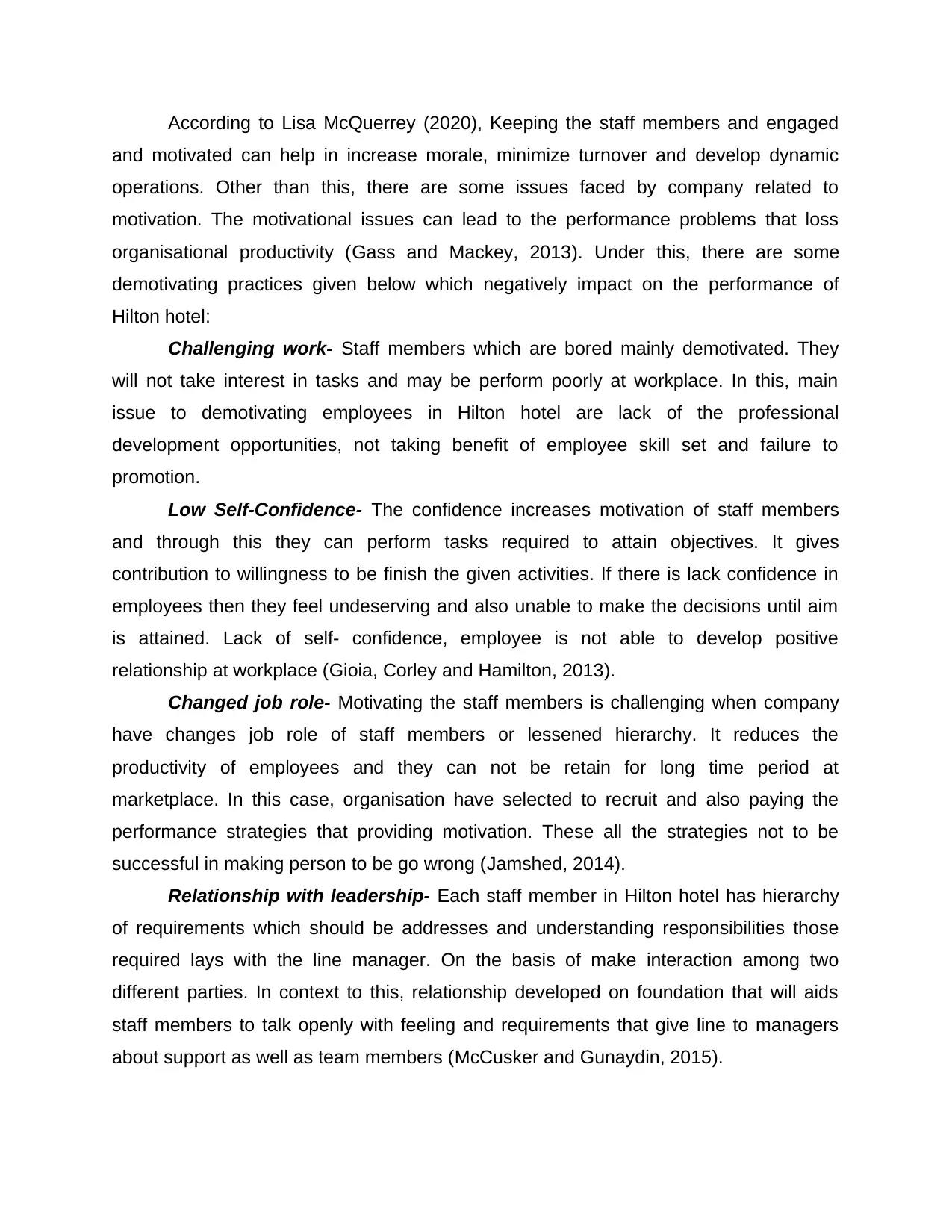
According to Lisa McQuerrey (2020), Keeping the staff members and engaged
and motivated can help in increase morale, minimize turnover and develop dynamic
operations. Other than this, there are some issues faced by company related to
motivation. The motivational issues can lead to the performance problems that loss
organisational productivity (Gass and Mackey, 2013). Under this, there are some
demotivating practices given below which negatively impact on the performance of
Hilton hotel:
Challenging work- Staff members which are bored mainly demotivated. They
will not take interest in tasks and may be perform poorly at workplace. In this, main
issue to demotivating employees in Hilton hotel are lack of the professional
development opportunities, not taking benefit of employee skill set and failure to
promotion.
Low Self-Confidence- The confidence increases motivation of staff members
and through this they can perform tasks required to attain objectives. It gives
contribution to willingness to be finish the given activities. If there is lack confidence in
employees then they feel undeserving and also unable to make the decisions until aim
is attained. Lack of self- confidence, employee is not able to develop positive
relationship at workplace (Gioia, Corley and Hamilton, 2013).
Changed job role- Motivating the staff members is challenging when company
have changes job role of staff members or lessened hierarchy. It reduces the
productivity of employees and they can not be retain for long time period at
marketplace. In this case, organisation have selected to recruit and also paying the
performance strategies that providing motivation. These all the strategies not to be
successful in making person to be go wrong (Jamshed, 2014).
Relationship with leadership- Each staff member in Hilton hotel has hierarchy
of requirements which should be addresses and understanding responsibilities those
required lays with the line manager. On the basis of make interaction among two
different parties. In context to this, relationship developed on foundation that will aids
staff members to talk openly with feeling and requirements that give line to managers
about support as well as team members (McCusker and Gunaydin, 2015).
and motivated can help in increase morale, minimize turnover and develop dynamic
operations. Other than this, there are some issues faced by company related to
motivation. The motivational issues can lead to the performance problems that loss
organisational productivity (Gass and Mackey, 2013). Under this, there are some
demotivating practices given below which negatively impact on the performance of
Hilton hotel:
Challenging work- Staff members which are bored mainly demotivated. They
will not take interest in tasks and may be perform poorly at workplace. In this, main
issue to demotivating employees in Hilton hotel are lack of the professional
development opportunities, not taking benefit of employee skill set and failure to
promotion.
Low Self-Confidence- The confidence increases motivation of staff members
and through this they can perform tasks required to attain objectives. It gives
contribution to willingness to be finish the given activities. If there is lack confidence in
employees then they feel undeserving and also unable to make the decisions until aim
is attained. Lack of self- confidence, employee is not able to develop positive
relationship at workplace (Gioia, Corley and Hamilton, 2013).
Changed job role- Motivating the staff members is challenging when company
have changes job role of staff members or lessened hierarchy. It reduces the
productivity of employees and they can not be retain for long time period at
marketplace. In this case, organisation have selected to recruit and also paying the
performance strategies that providing motivation. These all the strategies not to be
successful in making person to be go wrong (Jamshed, 2014).
Relationship with leadership- Each staff member in Hilton hotel has hierarchy
of requirements which should be addresses and understanding responsibilities those
required lays with the line manager. On the basis of make interaction among two
different parties. In context to this, relationship developed on foundation that will aids
staff members to talk openly with feeling and requirements that give line to managers
about support as well as team members (McCusker and Gunaydin, 2015).
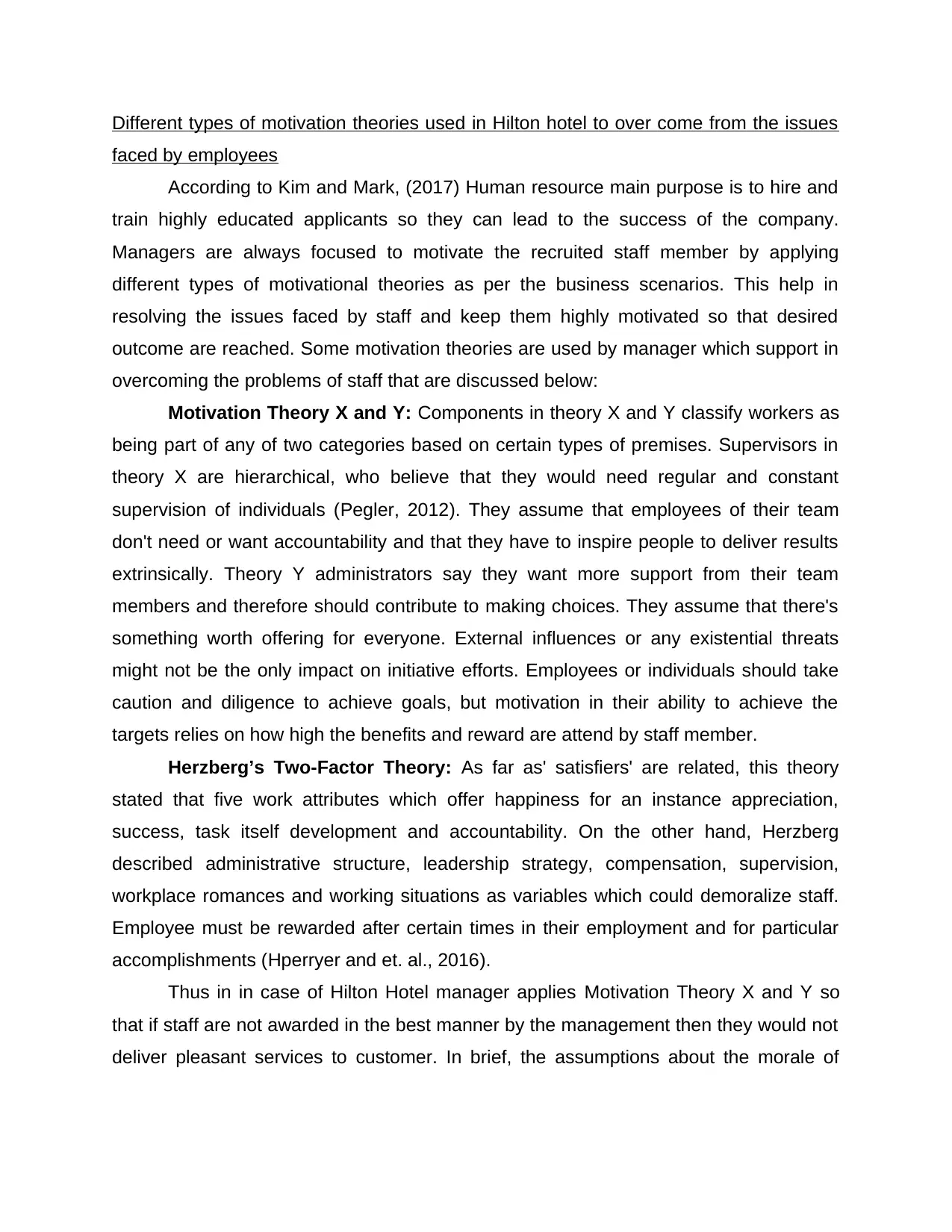
Different types of motivation theories used in Hilton hotel to over come from the issues
faced by employees
According to Kim and Mark, (2017) Human resource main purpose is to hire and
train highly educated applicants so they can lead to the success of the company.
Managers are always focused to motivate the recruited staff member by applying
different types of motivational theories as per the business scenarios. This help in
resolving the issues faced by staff and keep them highly motivated so that desired
outcome are reached. Some motivation theories are used by manager which support in
overcoming the problems of staff that are discussed below:
Motivation Theory X and Y: Components in theory X and Y classify workers as
being part of any of two categories based on certain types of premises. Supervisors in
theory X are hierarchical, who believe that they would need regular and constant
supervision of individuals (Pegler, 2012). They assume that employees of their team
don't need or want accountability and that they have to inspire people to deliver results
extrinsically. Theory Y administrators say they want more support from their team
members and therefore should contribute to making choices. They assume that there's
something worth offering for everyone. External influences or any existential threats
might not be the only impact on initiative efforts. Employees or individuals should take
caution and diligence to achieve goals, but motivation in their ability to achieve the
targets relies on how high the benefits and reward are attend by staff member.
Herzberg’s Two-Factor Theory: As far as' satisfiers' are related, this theory
stated that five work attributes which offer happiness for an instance appreciation,
success, task itself development and accountability. On the other hand, Herzberg
described administrative structure, leadership strategy, compensation, supervision,
workplace romances and working situations as variables which could demoralize staff.
Employee must be rewarded after certain times in their employment and for particular
accomplishments (Hperryer and et. al., 2016).
Thus in in case of Hilton Hotel manager applies Motivation Theory X and Y so
that if staff are not awarded in the best manner by the management then they would not
deliver pleasant services to customer. In brief, the assumptions about the morale of
faced by employees
According to Kim and Mark, (2017) Human resource main purpose is to hire and
train highly educated applicants so they can lead to the success of the company.
Managers are always focused to motivate the recruited staff member by applying
different types of motivational theories as per the business scenarios. This help in
resolving the issues faced by staff and keep them highly motivated so that desired
outcome are reached. Some motivation theories are used by manager which support in
overcoming the problems of staff that are discussed below:
Motivation Theory X and Y: Components in theory X and Y classify workers as
being part of any of two categories based on certain types of premises. Supervisors in
theory X are hierarchical, who believe that they would need regular and constant
supervision of individuals (Pegler, 2012). They assume that employees of their team
don't need or want accountability and that they have to inspire people to deliver results
extrinsically. Theory Y administrators say they want more support from their team
members and therefore should contribute to making choices. They assume that there's
something worth offering for everyone. External influences or any existential threats
might not be the only impact on initiative efforts. Employees or individuals should take
caution and diligence to achieve goals, but motivation in their ability to achieve the
targets relies on how high the benefits and reward are attend by staff member.
Herzberg’s Two-Factor Theory: As far as' satisfiers' are related, this theory
stated that five work attributes which offer happiness for an instance appreciation,
success, task itself development and accountability. On the other hand, Herzberg
described administrative structure, leadership strategy, compensation, supervision,
workplace romances and working situations as variables which could demoralize staff.
Employee must be rewarded after certain times in their employment and for particular
accomplishments (Hperryer and et. al., 2016).
Thus in in case of Hilton Hotel manager applies Motivation Theory X and Y so
that if staff are not awarded in the best manner by the management then they would not
deliver pleasant services to customer. In brief, the assumptions about the morale of
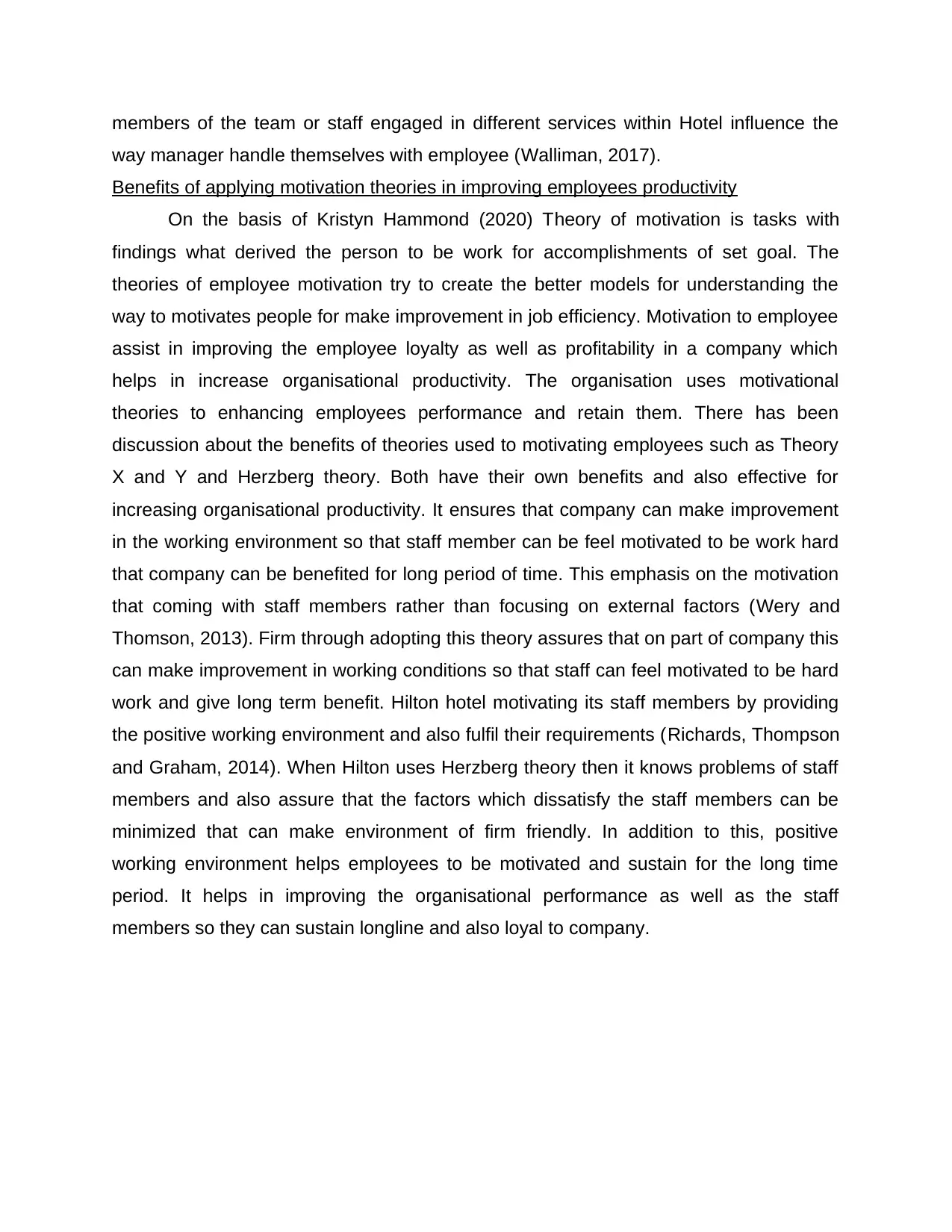
members of the team or staff engaged in different services within Hotel influence the
way manager handle themselves with employee (Walliman, 2017).
Benefits of applying motivation theories in improving employees productivity
On the basis of Kristyn Hammond (2020) Theory of motivation is tasks with
findings what derived the person to be work for accomplishments of set goal. The
theories of employee motivation try to create the better models for understanding the
way to motivates people for make improvement in job efficiency. Motivation to employee
assist in improving the employee loyalty as well as profitability in a company which
helps in increase organisational productivity. The organisation uses motivational
theories to enhancing employees performance and retain them. There has been
discussion about the benefits of theories used to motivating employees such as Theory
X and Y and Herzberg theory. Both have their own benefits and also effective for
increasing organisational productivity. It ensures that company can make improvement
in the working environment so that staff member can be feel motivated to be work hard
that company can be benefited for long period of time. This emphasis on the motivation
that coming with staff members rather than focusing on external factors (Wery and
Thomson, 2013). Firm through adopting this theory assures that on part of company this
can make improvement in working conditions so that staff can feel motivated to be hard
work and give long term benefit. Hilton hotel motivating its staff members by providing
the positive working environment and also fulfil their requirements (Richards, Thompson
and Graham, 2014). When Hilton uses Herzberg theory then it knows problems of staff
members and also assure that the factors which dissatisfy the staff members can be
minimized that can make environment of firm friendly. In addition to this, positive
working environment helps employees to be motivated and sustain for the long time
period. It helps in improving the organisational performance as well as the staff
members so they can sustain longline and also loyal to company.
way manager handle themselves with employee (Walliman, 2017).
Benefits of applying motivation theories in improving employees productivity
On the basis of Kristyn Hammond (2020) Theory of motivation is tasks with
findings what derived the person to be work for accomplishments of set goal. The
theories of employee motivation try to create the better models for understanding the
way to motivates people for make improvement in job efficiency. Motivation to employee
assist in improving the employee loyalty as well as profitability in a company which
helps in increase organisational productivity. The organisation uses motivational
theories to enhancing employees performance and retain them. There has been
discussion about the benefits of theories used to motivating employees such as Theory
X and Y and Herzberg theory. Both have their own benefits and also effective for
increasing organisational productivity. It ensures that company can make improvement
in the working environment so that staff member can be feel motivated to be work hard
that company can be benefited for long period of time. This emphasis on the motivation
that coming with staff members rather than focusing on external factors (Wery and
Thomson, 2013). Firm through adopting this theory assures that on part of company this
can make improvement in working conditions so that staff can feel motivated to be hard
work and give long term benefit. Hilton hotel motivating its staff members by providing
the positive working environment and also fulfil their requirements (Richards, Thompson
and Graham, 2014). When Hilton uses Herzberg theory then it knows problems of staff
members and also assure that the factors which dissatisfy the staff members can be
minimized that can make environment of firm friendly. In addition to this, positive
working environment helps employees to be motivated and sustain for the long time
period. It helps in improving the organisational performance as well as the staff
members so they can sustain longline and also loyal to company.
Paraphrase This Document
Need a fresh take? Get an instant paraphrase of this document with our AI Paraphraser
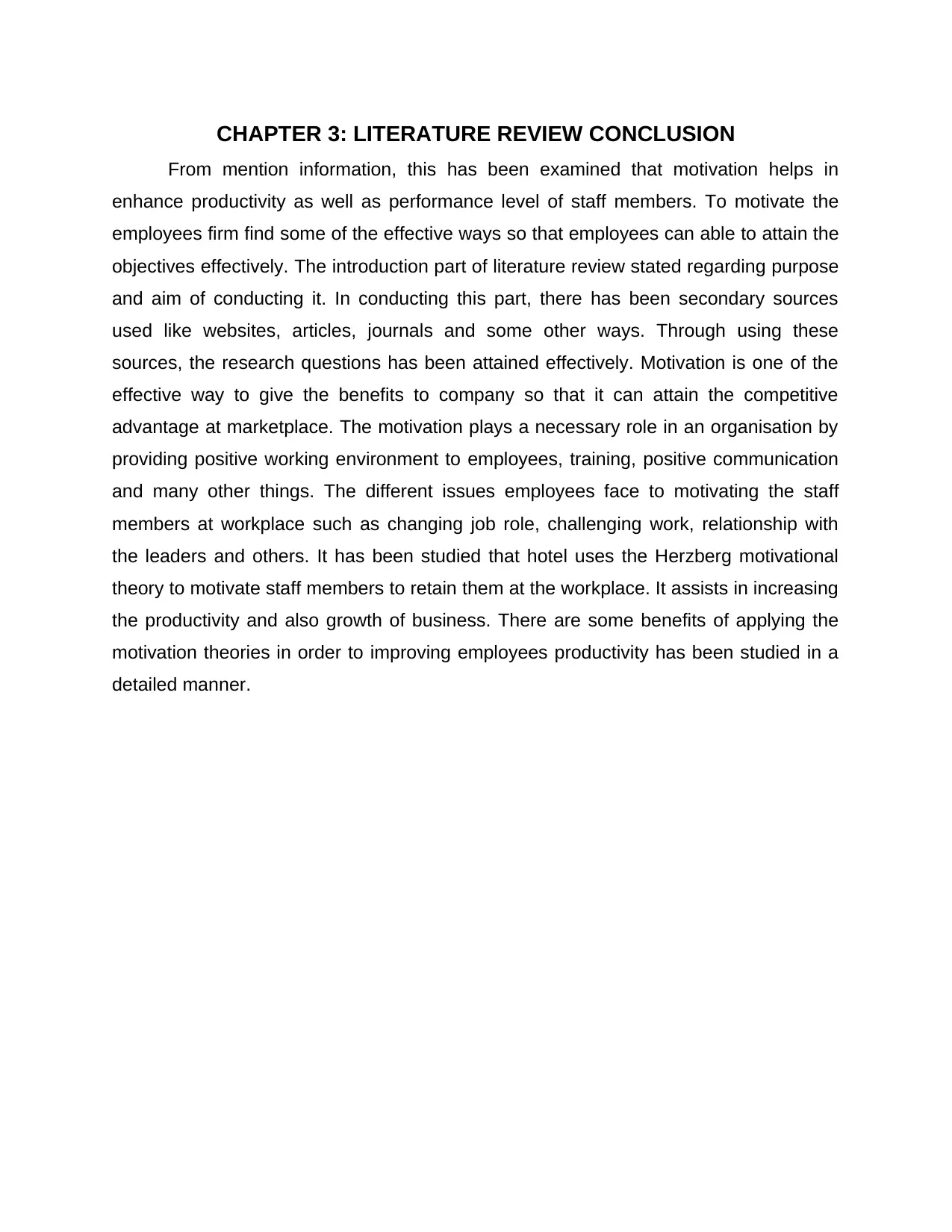
CHAPTER 3: LITERATURE REVIEW CONCLUSION
From mention information, this has been examined that motivation helps in
enhance productivity as well as performance level of staff members. To motivate the
employees firm find some of the effective ways so that employees can able to attain the
objectives effectively. The introduction part of literature review stated regarding purpose
and aim of conducting it. In conducting this part, there has been secondary sources
used like websites, articles, journals and some other ways. Through using these
sources, the research questions has been attained effectively. Motivation is one of the
effective way to give the benefits to company so that it can attain the competitive
advantage at marketplace. The motivation plays a necessary role in an organisation by
providing positive working environment to employees, training, positive communication
and many other things. The different issues employees face to motivating the staff
members at workplace such as changing job role, challenging work, relationship with
the leaders and others. It has been studied that hotel uses the Herzberg motivational
theory to motivate staff members to retain them at the workplace. It assists in increasing
the productivity and also growth of business. There are some benefits of applying the
motivation theories in order to improving employees productivity has been studied in a
detailed manner.
From mention information, this has been examined that motivation helps in
enhance productivity as well as performance level of staff members. To motivate the
employees firm find some of the effective ways so that employees can able to attain the
objectives effectively. The introduction part of literature review stated regarding purpose
and aim of conducting it. In conducting this part, there has been secondary sources
used like websites, articles, journals and some other ways. Through using these
sources, the research questions has been attained effectively. Motivation is one of the
effective way to give the benefits to company so that it can attain the competitive
advantage at marketplace. The motivation plays a necessary role in an organisation by
providing positive working environment to employees, training, positive communication
and many other things. The different issues employees face to motivating the staff
members at workplace such as changing job role, challenging work, relationship with
the leaders and others. It has been studied that hotel uses the Herzberg motivational
theory to motivate staff members to retain them at the workplace. It assists in increasing
the productivity and also growth of business. There are some benefits of applying the
motivation theories in order to improving employees productivity has been studied in a
detailed manner.
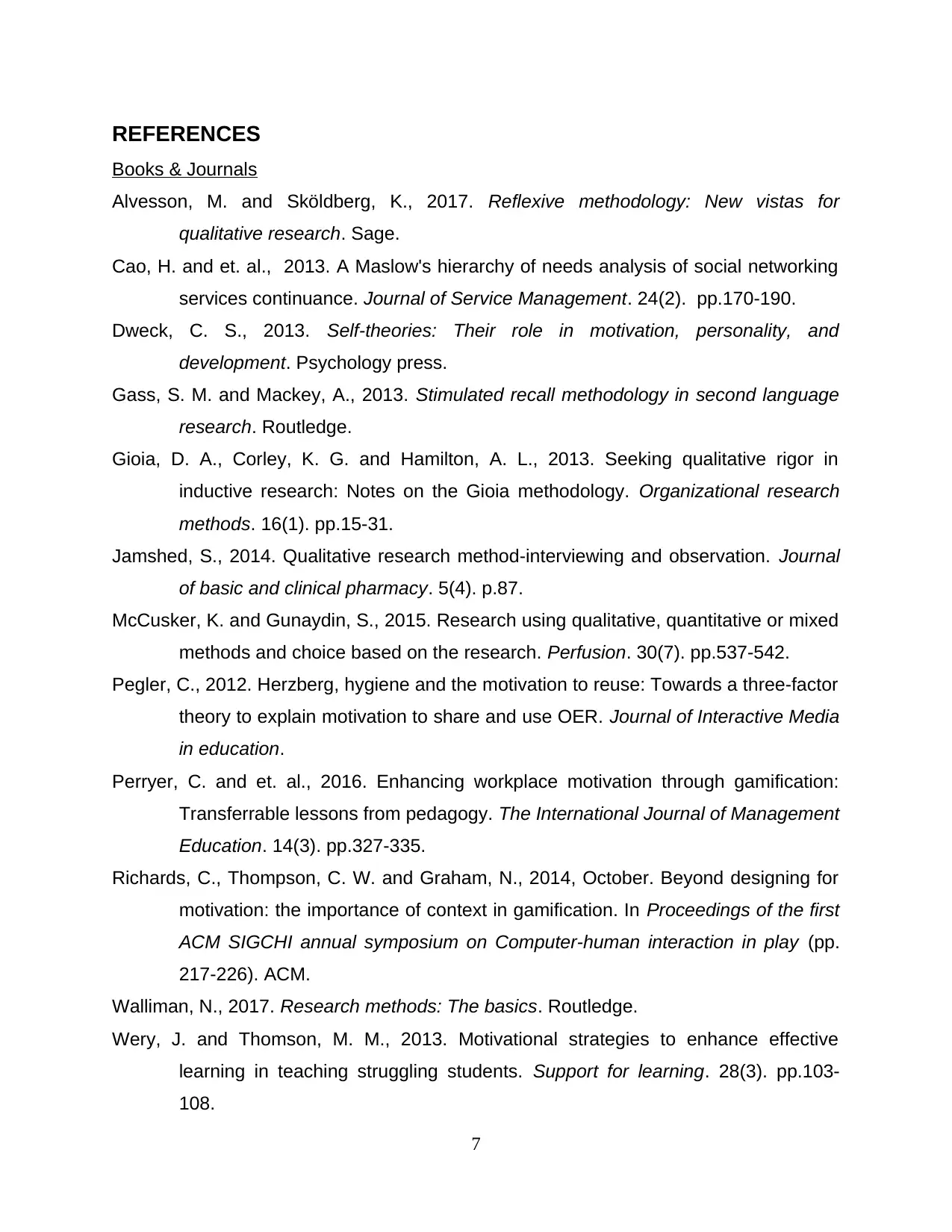
REFERENCES
Books & Journals
Alvesson, M. and Sköldberg, K., 2017. Reflexive methodology: New vistas for
qualitative research. Sage.
Cao, H. and et. al., 2013. A Maslow's hierarchy of needs analysis of social networking
services continuance. Journal of Service Management. 24(2). pp.170-190.
Dweck, C. S., 2013. Self-theories: Their role in motivation, personality, and
development. Psychology press.
Gass, S. M. and Mackey, A., 2013. Stimulated recall methodology in second language
research. Routledge.
Gioia, D. A., Corley, K. G. and Hamilton, A. L., 2013. Seeking qualitative rigor in
inductive research: Notes on the Gioia methodology. Organizational research
methods. 16(1). pp.15-31.
Jamshed, S., 2014. Qualitative research method-interviewing and observation. Journal
of basic and clinical pharmacy. 5(4). p.87.
McCusker, K. and Gunaydin, S., 2015. Research using qualitative, quantitative or mixed
methods and choice based on the research. Perfusion. 30(7). pp.537-542.
Pegler, C., 2012. Herzberg, hygiene and the motivation to reuse: Towards a three-factor
theory to explain motivation to share and use OER. Journal of Interactive Media
in education.
Perryer, C. and et. al., 2016. Enhancing workplace motivation through gamification:
Transferrable lessons from pedagogy. The International Journal of Management
Education. 14(3). pp.327-335.
Richards, C., Thompson, C. W. and Graham, N., 2014, October. Beyond designing for
motivation: the importance of context in gamification. In Proceedings of the first
ACM SIGCHI annual symposium on Computer-human interaction in play (pp.
217-226). ACM.
Walliman, N., 2017. Research methods: The basics. Routledge.
Wery, J. and Thomson, M. M., 2013. Motivational strategies to enhance effective
learning in teaching struggling students. Support for learning. 28(3). pp.103-
108.
7
Books & Journals
Alvesson, M. and Sköldberg, K., 2017. Reflexive methodology: New vistas for
qualitative research. Sage.
Cao, H. and et. al., 2013. A Maslow's hierarchy of needs analysis of social networking
services continuance. Journal of Service Management. 24(2). pp.170-190.
Dweck, C. S., 2013. Self-theories: Their role in motivation, personality, and
development. Psychology press.
Gass, S. M. and Mackey, A., 2013. Stimulated recall methodology in second language
research. Routledge.
Gioia, D. A., Corley, K. G. and Hamilton, A. L., 2013. Seeking qualitative rigor in
inductive research: Notes on the Gioia methodology. Organizational research
methods. 16(1). pp.15-31.
Jamshed, S., 2014. Qualitative research method-interviewing and observation. Journal
of basic and clinical pharmacy. 5(4). p.87.
McCusker, K. and Gunaydin, S., 2015. Research using qualitative, quantitative or mixed
methods and choice based on the research. Perfusion. 30(7). pp.537-542.
Pegler, C., 2012. Herzberg, hygiene and the motivation to reuse: Towards a three-factor
theory to explain motivation to share and use OER. Journal of Interactive Media
in education.
Perryer, C. and et. al., 2016. Enhancing workplace motivation through gamification:
Transferrable lessons from pedagogy. The International Journal of Management
Education. 14(3). pp.327-335.
Richards, C., Thompson, C. W. and Graham, N., 2014, October. Beyond designing for
motivation: the importance of context in gamification. In Proceedings of the first
ACM SIGCHI annual symposium on Computer-human interaction in play (pp.
217-226). ACM.
Walliman, N., 2017. Research methods: The basics. Routledge.
Wery, J. and Thomson, M. M., 2013. Motivational strategies to enhance effective
learning in teaching struggling students. Support for learning. 28(3). pp.103-
108.
7
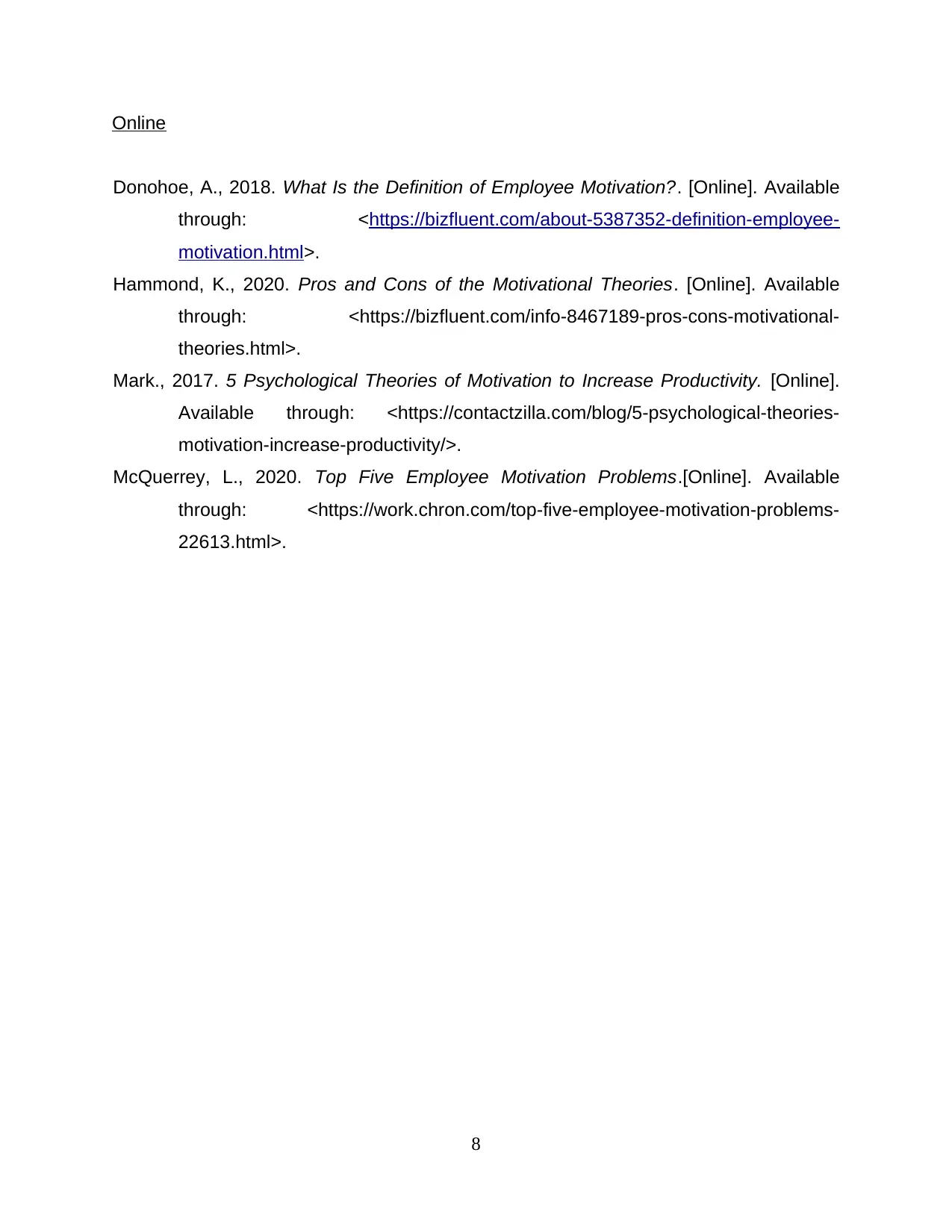
Online
Donohoe, A., 2018. What Is the Definition of Employee Motivation?. [Online]. Available
through: <https://bizfluent.com/about-5387352-definition-employee-
motivation.html>.
Hammond, K., 2020. Pros and Cons of the Motivational Theories. [Online]. Available
through: <https://bizfluent.com/info-8467189-pros-cons-motivational-
theories.html>.
Mark., 2017. 5 Psychological Theories of Motivation to Increase Productivity. [Online].
Available through: <https://contactzilla.com/blog/5-psychological-theories-
motivation-increase-productivity/>.
McQuerrey, L., 2020. Top Five Employee Motivation Problems.[Online]. Available
through: <https://work.chron.com/top-five-employee-motivation-problems-
22613.html>.
8
Donohoe, A., 2018. What Is the Definition of Employee Motivation?. [Online]. Available
through: <https://bizfluent.com/about-5387352-definition-employee-
motivation.html>.
Hammond, K., 2020. Pros and Cons of the Motivational Theories. [Online]. Available
through: <https://bizfluent.com/info-8467189-pros-cons-motivational-
theories.html>.
Mark., 2017. 5 Psychological Theories of Motivation to Increase Productivity. [Online].
Available through: <https://contactzilla.com/blog/5-psychological-theories-
motivation-increase-productivity/>.
McQuerrey, L., 2020. Top Five Employee Motivation Problems.[Online]. Available
through: <https://work.chron.com/top-five-employee-motivation-problems-
22613.html>.
8
1 out of 10
Related Documents
Your All-in-One AI-Powered Toolkit for Academic Success.
+13062052269
info@desklib.com
Available 24*7 on WhatsApp / Email
![[object Object]](/_next/static/media/star-bottom.7253800d.svg)
Unlock your academic potential
© 2024 | Zucol Services PVT LTD | All rights reserved.





